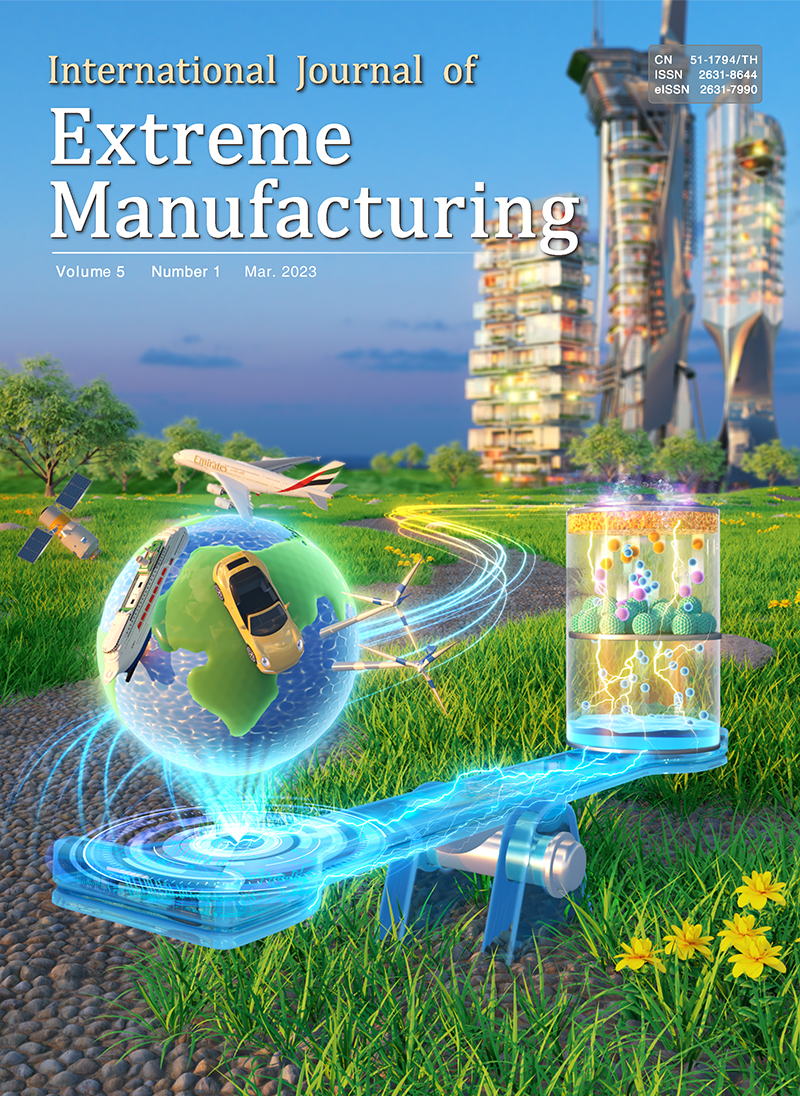PAPER ● OPEN ACCESSRead More
1. Introduction
As one of the most active research fields in laser manufacturing, femtosecond (fs) laser precision machining has shown prominent advantages in manufacturing micro/nanoscale components, with their capabilities being continuously advanced to new boundaries such as smaller geometries and higher resolutions. On the other hand, as the applications of fs laser precision machining are extended from micro/nanoscales to macroscales, approaches to sustaining micro/nanoscale precisions in both shapes and dimensions when machining geometries above millimeters (mm) are in great demand. In fs laser machining, achieving micro/nanoscale precisions can be more challenging at larger overall sizes due to more complex machining routes required and more significant influences from the defocusing of laser beams, which hinder fs laser machining from being widely applied. A major obstacle to reaching high precisions (e.g., < 10 µm) when machining macroscale geometries (e.g., diameters and depths ≥ 1 mm) is to achieve sharp edges and vertical sidewalls simultaneously. Both tapered sidewalls and poor-quality edges are usually formed when machining macroscale holes using fs lasers through two-dimensional galvo scanners [figures 1(a), (d), (g), (j)]. The use of a five-axis (5-axis) scanner permits tuning of sidewall tapers from positive (i.e., entrances > exits) to negative (i.e., entrances < exits). However, poor-quality edges with rough chamfers at the entrances have remained to be a challenge [figures 1(b), (e), (h), (k)], particularly when machining deep holes where tunings fs laser focal spots along the depth direction is inevitable. Qiuchi Zhu, Dr. Peixun Fan, Nan Li, Timothy Carlson, Drs. Bai Cui, Jerry L. Hudgins, Yong Feng Lu from University of Nebraska-Lincoln, and Dr. Jean-Francois Silvain from CNRS, University of Bordeaux, France, published an article "Femtosecond-laser sharp shaping of millimeter-scale geometries with vertical sidewalls" on IJEM. In this research, the authors developed an fs-laser sharp shaping approach to simultaneously realizing vertical sidewalls as well as sharp hole entrances and exits in macroscale machining using a 5-axis scanner [figure 1(c), (f), (i), (l)]. For the first time, the fs laser ablation behaviors in actual manufacturing were flexibly controlled, through which a parameter-compensation strategy was developed to improve both sidewall and edge qualities.
Highlights
A fs-laser sharp shaping approach was developed for achieving micro/nanoscale precisions in macroscale machining in this article:
● Sharp edges and vertical sidewalls are simultaneously achieved by angle-of-incidence (AOI) control and parameter compensations.
● Through adjusting the AOI, the edge transition width can be reduced to below 10 µm but at a cost of increased sidewall tapers.
● Through both scanning-diameter and laser-power compensations, zero-tapered sidewalls can be produced while keeping the edge transition width below 10 µm.
● In addition to AOI which is most commonly used to tune tapers, this research indicates that controlling the fs-laser ablation behaviors via parameter compensation can also realize tuning of sidewall tapers from positive to negative.
● The AOI control combined with the parameter compensation provides a versatile solution to simultaneously achieve vertical sidewalls and sharp edges for various geometries, reaching dimensional precisions below 10 µm and surface roughness below 1 µm.
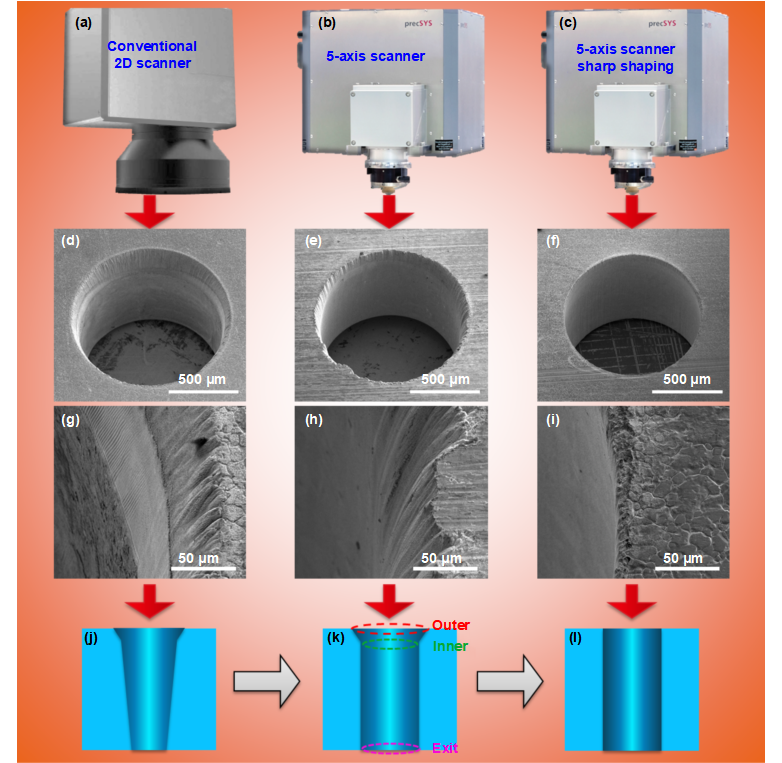
Figure 1. (a)-(c) Different machining approaches and (d)-(i) the corresponding typical machining results. (j)-(l) Schematics of cross-sections of holes machined by the different approaches.
2. Background
Higher precisions are a major goal being continuously pursued in most modern manufacturing techniques. Nowadays, micro/nanoscale precisions have been achieved through different methods but primarily for microscale geometries. However, machining macroscale geometries while keeping precisions at micro/nanoscales is still a remaining challenge. In fs laser machining, particularly, a major obstacle to reaching high precisions in macroscale machining is to achieve sharp edges and vertical sidewalls simultaneously. In this research, a fs-laser sharp shaping approach was developed based on an AOI control and parameter-compensation strategy. The evolution of edge sharpness (edge transition width, or edge widths for short) and sidewall tapers were systematically investigated through which the dilemma of simultaneously achieving sharp edges and vertical sidewalls were addressed.
3. Recent Advances
AOI control for obtaining sharp edges
The preliminary experiments showed that sidewalls with near-zero tapers can be produced even at an AOI of 0° when proper fs laser conditions were used through a 5-axis scanner. However, poor-quality edges with rough chamfers at the entrances were formed, particularly when machining deep holes. Therefore, the mechanism underlying the formation of poor-quality edges was investigated, with the defects on the edges mainly attributed to the beam divergence in macroscale machining. Then, different AOIs were tested to improve the edge qualities. The edges became sharper and smoother as larger AOIs were used (figure 2), with the edge widths reduced from above 50 µm to below 10 µm. However, using larger AOIs obviously increased the exit diameters at the same time, resulting in larger sidewall tapers. Producing vertical sidewalls with sharp edges cannot be realized by simply controlling the AOI.
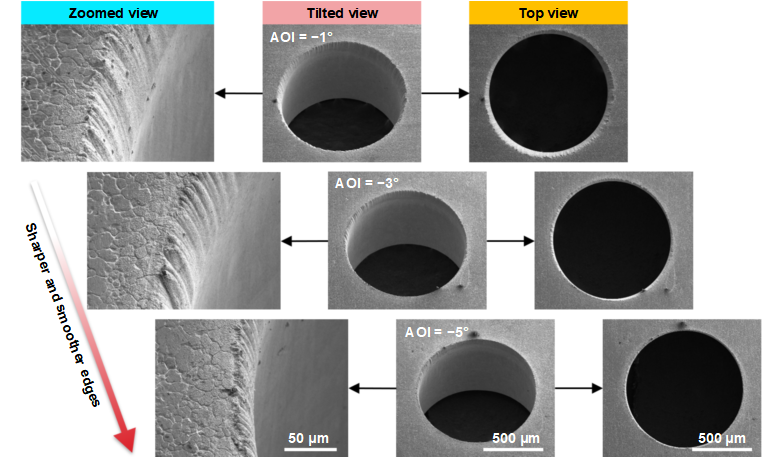
Figure 2. Sharper and smoother edges achieved by decreasing the AOI from -1° to -5°.
Parameter-compensation strategy for obtaining vertical sidewalls
To solve the dilemma of difficulties in achieving sharp edges and vertical sidewalls simultaneously, the fs-laser ablation behaviors were analyzed. As illustrated in figure 3(a), the overall ablation can be considered to be composed of the vertical and lateral ablation at oblique incidences. The vertical ablation is for machining deeper holes while the lateral ablation is for increasing hole diameters. When a constant scanning diameter is used at oblique incidences, the laser ablation occurs vertically and laterally at the same time, causing cone-shaped holes with negative sidewall tapers. Although the vertical ablation is always the major part of the overall ablation at small AOIs, the lateral ablation increases at larger AOIs, resulting in larger sidewall tapers. Since the AOI is necessary to achieve sharp edges, preventing lateral ablation at oblique incidences is the key to vertical sidewalls. Accordingly, two specific parameters were carefully adjusted to compensate for lateral ablation (i.e., the scanning diameter and the laser power), with a parameter-compensation strategy developed. Gradually decreasing the scanning diameters along the depth is defined as the scanning-diameter compensation (diameter compensation) in this research [figure 3(b)]. In addition, using the optimal laser power is defined as the laser-power compensation [power compensation, figure 3(c)]. Both scanning-diameter and laser-power compensations were applied to reduce lateral ablation and ensure that the majority of laser ablation occurs vertically.
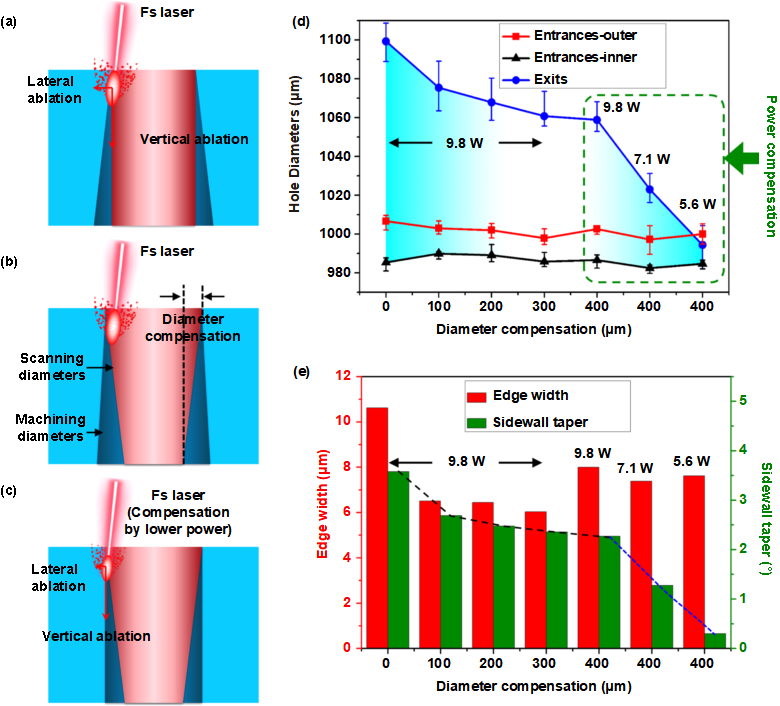
Figure 3. (a)-(c) Schematics of the parameter-compensation strategy: (a) laser machining with unoptimized power and a constant scanning diameter, (b) laser machining with unoptimized power and scanning-diameter compensation, (c) laser machining with both scanning-diameter and laser-power compensations. The red and dark-blue shadows represent the programmed scanning diameters and the machined hole diameters, respectively. The laser focal spot shown in (c) is smaller than that shown in (a) and (b), indicating that a lower laser power was used. (d) Effect of scanning-diameter and laser-power compensation on reducing the diameter differences between the entrances and exits. (e) Influence of parameter compensation on edge width and sidewall taper.
The scanning-diameter compensation reduces lateral ablation through conducing off-focus ablation at the sidewalls, while the laser-power compensation is based on the dependence of ablation on laser fluences. The scanning-diameter compensation effectively reduces the exit diameters, making them closer to the entrance diameters [figure 3(d, e)]. However, the effect of scanning-diameter compensation weakens when using larger diameter compensations and, hence, cannot completely eliminate sidewall tapers. The laser power has a more obvious influence on fs laser ablation. When lower laser powers are used as parameter compensations, the lateral ablation decreases more than the vertical ablation since the former is only a small portion of the overall laser ablation [figure 3(c)]. Accordingly, the proportion of lateral versus vertical ablation is reduced, producing vertical sidewalls (sidewall taper as low as 0.3°) and even inverted-cone holes [figure 3(d, e)]. At the same time, the edge widths were kept below 10 µm. The surface finish inside the holes was also examined, verifying that the parameter-compensation strategy can machine mm-scale holes with dimensional precisions < 10 µm and surface roughness < 1 µm. The success in achieving non-tapered sidewalls with sharp edges through parameter compensation verified the effectiveness in manipulating the fs laser ablation behaviors in actual manufacturing.
Machining diverse and complex geometries
In addition to round holes, the AOI control and parameter compensation can also be used to machine complex geometries of macroscale sizes. For example, an elliptical hole [figure 4(a)], a combination of two-crossed ellipses [figure 4(b)], and a dumbbell-like geometry [figure 4(c)] have been machined. In spite of their complex shapes, vertical sidewalls along with sharp, clean entrances and exits were achieved on all parts of these geometries. The success in machining such free-shaped geometries verifies that the AOI control and parameter-compensation strategy developed in this research has no obvious dependence on the geometries to be machined and, thus, can be used as a general approach to macroscale machining.
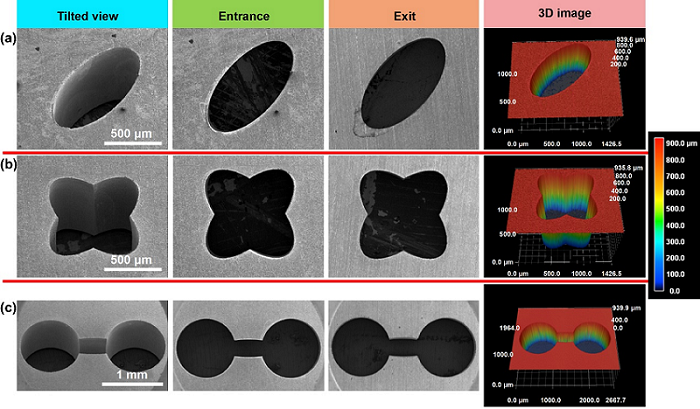
Figure 4. Geometries of different shapes with non-tapered sidewalls and sharp edges: (a) a single ellipse, (b) two crossed ellipses, and (c) a dumbbell-like geometry.
4. Perspectives
This article demonstrates the capability of fs lasers in macroscale machining in addition to its prominent advantages in micro/nanoscale manufacturing. In addition to explore the capability of fs lasers in macroscale manufacturing, the authors believe that the strategy studied in this research can also establish a novel approach to finely controlling fs-laser ablation behaviors in real manufacturing processes and, hence, establishes the capability of fs lasers in macroscale machining with micro/nanoscale precisions. The know-how and technology established can find broad applications in the manufacturing of key components in the thermonuclear fusion, complicated parts in the aerospace field, and demanding products in the electronic industry.
5. About the Authors
This article demonstrates the capability of fs lasers in macroscale machining in addition to its prominent advantages in micro/nanoscale manufacturing. In addition to explore the capability of fs lasers in macroscale manufacturing, the authors believe that the strategy studied in this research can also establish a novel approach to finely controlling fs-laser ablation behaviors in real manufacturing processes and, hence, establishes the capability of fs lasers in macroscale machining with micro/nanoscale precisions. The know-how and technology established can find broad applications in the manufacturing of key components in the thermonuclear fusion, complicated parts in the aerospace field, and demanding products in the electronic industry.

Dr. Peixun Fan is currently a research assistant professor in the Department of Electrical and Computer Engineering at the University of Nebraska-Lincoln (UNL). He received his B.E. degree from Huazhong University of Science and Technology in 2009, and his Ph.D. degree from Tsinghua University in 2014. After that, he has devoted years at Tsinghua University, University of Virginia, and University of Nebraska-Lincoln in the research of ultrafast laser subtractive and additive micro-nano manufacturing and laser extreme manufacturing technologies. He has been the major researcher for multiple projects from both academic and industrial sponsors including National Natural Science Foundation of China, U.S Department of Energy, U.S Navy Research Lab, MIT, Stanford University, University of Rochester, Corning Incorporated, Mitsubishi Heavy Industries Ltd, etc. Through these projects, he has developed over 10 laser micro-nano manufacturing technologies for addressing the major challenges in critical areas like the inertial confinement fusion. Dr. Fan has made over 60 publications in peer-reviewed journals and international conferences, five patents, and three book chapters, including 14 first/co-first authored papers in top journals like ACS Nano, Nano Letters, Nano Energy, etc. He has delivered multiple invited talks in the top international conferences in the area of laser manufacturing, like ICALEO, ALAT, etc. His publications have been cited for over 1700 times in many top journals including Nature Communications, Advanced Materials, Advanced Functional Materials, etc.







